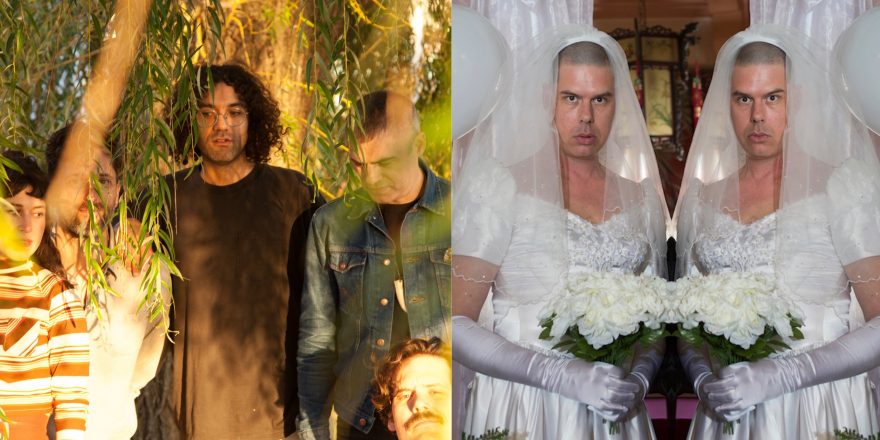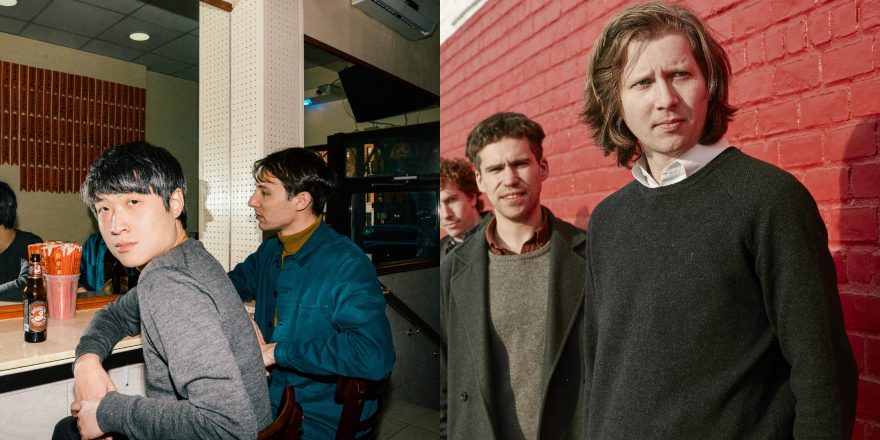Angus Andrew is the founding member of the Australian-American electronic punk band Liars; Jonathans Schenke and Campolo are members of the Brooklyn-based DIY supergroup P.E. Here, the friends and collaborators talk how Angus remixed a P.E. song, their recording processes, and P.E.’s forthcoming debut album.
— Annie Fell, Talkhouse Senior Editor
Johnathan Schenke: Hey Angus, it’s Johnny and Johnny. There are two Johnnys here.
Angus Andrew: Johnny Two Eyes.
Schenke: Well, I’m Johnny Two Eyes and then there’s Johnny—
Jonathan Campolo: One eye.
Angus: So three eyes total.
Schenke: Something like that.
Campolo: How are you doing man?
Angus: You know, I was just emailing my manager to ask him what’s OK for me to talk about, in terms of the current film score I’m doing. So I’m just going to write a question mark right there and then send that off right now.
OK, so two Johnnys — both of you in the band?
Campolo: Yes.
Angus: Pill Eaters.
Schenke: Well, we shortened it. It’s just P.E.
Angus: So that was the name, but originally of two bands. One band was called Pill and one band was called Eaters.
Schenke: Exactly.
Angus: And then both bands disbanded?
Schenke: Well, Eaters is still going, it’s just a kind of project that changes whenever we get together. Right now it’s in this sound sculpture/art installation/microtonal drone position.
Campolo: They play a goddamn glass harmonica.
Angus: So how many people are in that band?
Schenke: There are three of us. It’s myself and Bob [Jones], who is also in P.E., and then a glass sculptor named Chris Duffy.
Angus: Nice. And then on top of Eaters there’s Pill. Johnny, you’re in that also?
Campolo: Yeah, I’m in that band. But that band disbanded earlier this year.
Angus: Under good terms?
Campolo: Under good terms. That’s what my lawyer told me to say.
Angus: The thing that is interesting, or probably at least a good place to start, is how we met.
Schenke: We met through Sweet John Rau.
Angus: Sweet John Rau. So John Rau is a sound engineer who I’ve toured with very extensively. How do you know John?
Schenke: I know John just from New York. He’s done sound for Eaters a bit.
Angus: Then how did we get in touch?
Schenke: Well, I was hanging out with John in Portland and I played him the record. He was the one that was adamant that I send it to him so he could send it to you. He knew that it would be something you’d be into. And that’s where it sparked the idea of reaching out about the remix.
Angus: Yes. Well, I had always said to John Rau — because I knew that he was living in New York and doing a lot of touring nonstop with so many different people — I always told John, “Keep an eye out for me, mate,” because I’m a bit out of it in the bush. And he sent your guys’ stuff down, and of course he was right that we were like-minded.
Schenke: If you could sort of talk about the remix, walk us through — did you have something in mind when you started, or was it just sort of a dive-in-and-that’s-what-came-out?
Angus: Definitely a dive-in-and-that’s-what-came-out. Normally I listen to it and then I kind of extract the bits that I like the best, and if I’m working with a vocal, then obviously the vocal. And then I just kind of go to town and do whatever. That sounds really boring in a production style, but experimenting is always my go-to rather than any kind of premeditated sort of plan. I’m a throw-everything-at-the-wall-and-look-at-it-for-a-while kind of person. And usually what happens is if I find some way of making it fun and dancey, because I still think a remix is, you want to be in the club. I want to make it fun.
It’s always great to work with other people’s vocals and other people’s words. I always get obsessed with vocal lines when I do remixes, and your song is especially good for that.
Schenke: Veronica [Torres]’s got all those good one-liners on the record.
Angus: “I need strict compliance.” That was the one I wanted. I could have had that just repeating the whole time and I would have been happy with that.
Campolo: Corporate speak.
Angus: So as a couple of hip dudes in Brooklyn, where does the concept of a remix really lie, in terms of its applicability and who cares?
Campolo: I think it’s fun, because what you brought into doing our remix was that you can sort of kill the preciousness of the original. Not so much like decimating something or bastardizing the sound, but you can really turn it on its head in a way. I think our album was enough of a curveball that you brought it even further into left field, which was perfect.
What you see in Brooklyn a lot is people doing — the cover song is kind of like a close cousin to the remix, in a way, and what people are doing is either updating a classic or doing something so contemporary. People like to re-update classics. Like, I’m seeing so much Talking Heads in Brooklyn. It’s crazy, man.
Schenke: Yeah, there was a whole night and our friends were like the backing band of Talking Head covers. It was like a greatest hits.
Angus: Is it really rude for me to say that I’m not into Talking Heads at all?
Campolo: They’re all here and they’re all shaking their heads right now. They hate you.
Schenke: David Byrne’s sitting back here really looking upset.
Angus: I missed the boat on them and that’s OK. I just had a massive Tom Tom Club day yesterday, but not Talking Heads for some reason. I don’t know.
Schenke: Maybe one day.
Angus: So in the live shows, what’s your guys’ set up?
Schenke: So, the project started with a live show that we did for a friend’s record release show. The idea was just to jam, so we had this improvised set. We had a couple practice sessions beforehand.
Campolo: Did Bob have this machine then?
Schenke: Yeah, like an E-mu SP-12 sampling drum machine from the ‘80s. It’s like a 12-bit sampler.
Campolo: It’s a beast, man.
Schenke: Yeah, it’s very fun. It’s got faders and big old buttons that feel like you’re hitting an arcade game. You were playing bass and synth and effects, and I had an MS-20 doing process vocals. Ben was playing sax, Veronica just wanted to sing. We all just kind of showed up with these things that were like, “I would like to play this.” These sounds started to come.
The show was really fun and then Johnny and Bob and I came into my studio a few weeks later and just spent the weekend recording. I think we recorded for hours.
Campolo: Yeah. Sort of like how you were describing a maximalist approach, where you just see what sticks, we just kept rolling with no primary focus or direction at all. Just hit record and kind of lay back into the weekend, really.
Schenke: It was just people in the room like, “I have an idea,” then we’d put it down and that would spark something else. We’d start to build up this stuff, and it kind of goes back to [the idea of] carving away and making a collage of things.
Campolo: It’s like being maximalist, and only subtracting in editing.
Schenke: Yeah, things like, maybe we have a seven- or eight-minute jam and what Veronica and Ben are doing later on in it really feels like the chorus, so we’d chop that out and move it up and that becomes the refrain.
Angus: So how many songs did you guys have? Did you leave any out?
Scheke: Yeah, there’s some really weird shit on my hard drive somewhere.
Campolo: Should we send you all the weird shit?
Angus: Of course, you’ve gotta send me the weirdest shit.
Schenke: I think 12 ideas made the record, and we had something like 20. Some of those are very meandering.
Campolo: There’s a thin line between something that’s barely even there and a song that makes a record.
Angus: Yeah, really. And it’s the simplest things that work so obviously and so clearly and so immediately, and you know it straight away. Then there are those ones that are almost there, and they can sit there for ages.
Schenke: There’s always that one song on the record that you spend an inordinate amount of time working on. It’s the albatross of the record.
Campolo: And it doesn’t show. [Laughs.]
Angus: It’s never the one anyone cares about.
Campolo: It’s not like a painting where you can see all the strokes — nobody hears it at all.
Schenke: What I always tell people is, just because you can edit or refine or quantize or tune or whatever doesn’t mean you should. For me, there’s a threshold for every project where it’s like, yeah that’s not quite “right,” but if it’s below the threshold I’ll leave it, because that’s what makes it feel human. On this P.E. record, there’s a lot of really out of time shit where we were like, “Well, that adds to the charm.”
What are you up to? I know there’s the super secret thing that you’re not sure if you can talk about.
Campolo: Oh, right. Did you hear back from him?
Angus: He said it’s fine. I’m doing a soundtrack right now for a film that’s called Becky, which is sort of like modern thriller with a young female protagonist. It’s cool, man. It’s fun, but it’s a lot of work. I’m just so snowed in with scenes I’m behind on. But it’s fun.
Campolo: Is it a lot of back and forth? Like, are they giving you heavy direction?
Angus: Yeah. There’s a lot more direction than the one I’d done previously, which was a few years ago, and that was a lot more like, I just made a ton of stuff and then we kind of made it fit where it should go. This is like: “At the 27-minute mark, it’s gotta do this!” It’s kind of intense. It’s just amazing just on this project how much music is actually being generated, a small amount of which is making it through into the movie. It’s just incredible to be forced to make so much. It’s so cool. I love it, really.
Campolo: Soundtracking is amazing.
Schenke: Are you keeping the discarded bits for something?
Angus: Oh, yeah. I always keep everything. There’s always a lot of leftovers with every project, so it’s good to keep everything for me.
Schenke: How much do you see the overlapping, say, of doing a soundtrack like this compared to the band that you hired or the record you did on your own? Are there certain things that you recognize?
Angus: I don’t know. At the bottom of everything is a sort of level of confidence that I think is kind of necessary in terms of the different ways of making music that I’ve done, where you’re just going to have to believe in it and know that it’s going to work and that you’re doing it for a reason. It’s not always been that easy to be that confident about what you’re doing. It’s just great to know you guys can send me something to do a remix, and I just feel like I know it’s going to work out well.
Soundtrack stuff is great. I love sound. I go back and forth between how much I like a well-written song verse, and an amazing sort of sounding piece of sound. My whole sort of musical career has really been just kind of going back and forth between writing straightforward songs or just making sounds. I’m really happy in both realms. It’s interesting, at the moment, I’m actually judging the Australian Music Prize.
Campolo: No way!
Angus: I have to listen to so many records, it’s out of control.
Campolo: Are they all over the place? Like country, blues?
Angus: Yeah, yeah. I get nine a week or something that I gotta listen to.
Campolo: It’s like the CD club. Remember the CD club?
Schenke: Columbia House.
Campolo: That sounds terrible. I mean, no offense, I’m sure it’s prestigious.
Angus: It’s just interesting for me. Of course it’s a bit of an honor for me, but also it’s a real learning experience in terms of this question of songwriting versus sound. Part of the idea of judging the thing is that you’ve got to think that the winner is unique in some way. So it feels like you should be writing off every kind of singer-songwriter thing. But then you’re forced to listen to it and you think, Well, they’ve actually written a really great song here. So what do you do? It’s not advancing humankind in a massive way, but it is technically a really well-written song and I can appreciate that. But more and more, music is starting to verge on sound design. That is more interesting to me.
Campolo: Yeah. When you say that I think of like…
Schenke: I mean, hip hop.
Campolo: Definitely. There’s a lot more sound design in hip hop, and especially soundscape in hip hop nowadays.
Angus: Yes, yes, yes. And has been for ages. The real pushing the boundaries of production has all come from hip hop. I was thinking about that, the 808 kick drum and how melodic it is, the other day. It really was a big innovation in the sound when that became huge so recently. And the high hats thing.
Schenke: Like trap hats.
Angus: Yeah. It’s so cool.
Campolo: They’re not going away, those high hats. Never.
Angus: Never? [Laughs.]
Campolo: Never.
Angus: That’s innovation that is not coming around through rock & roll bands for sure.
Campolo: But it’s much more… Like, for instance, coming out of a rock & roll band most recently and into this band that [is], like, chest-deep in electronic music — it blows open the whole universe of it, and it all of a sudden seltzer water in a cup could be an instrument. You start thinking about music in a completely different way. It’s really nice.
Schenke: Zag-zagging between song and sound design — for me, the sweet spot in the middle is always really refreshing. There’s a lot to mine out of that. I was talking with Ben, our sax player, about the sweet and sour aspects — where if you have something really catchy, but also the grating noise underneath, that’s where people from both camps can really agree, “There’s something happening here. I want to listen to this again.”
Angus: Yeah. There is a sweet spot in there somewhere, and we’re all just trying to find it, aren’t we?
Campolo: Yeah. Angus, what’s your favorite sound? Not your favorite song, your favorite sound.
Angus: I’ve always really liked the sound of feet on gravel.
Schenke: That’s a good one.
Campolo: Huge one.
Angus: Yeah, I love that one. It reminds me of another great sound and great live moment when I saw Bjork performing with Matmos for the record that they did [Vespertine]. The Matmos dudes were on stage and they had their feet in these little containers that had styrofoam in it, and those were miked and they were doing the beat by just walking on the styrofoam. So cool.
Campolo: Oh man. That’s basically like straight up foley.
Schenke: Have you ever seen Matmos? It is like a live foley act.
Angus: Yeah. Really amazing. What’s your favorite sound?
Campolo: I thought you were going to say mine — I grew up in New England, which is like Arctic winter, and it’s definitely feet on snow. Really nostalgic. It has like a crunch, and then a dense boom at the bottom — it’s a really good one.
Angus: It can be super crispy. The highs or something in that makes my teeth tingle. And what about you, Johnny One Eye?
Schenke: No, I’m One.
Campolo: Shit, we’re getting it fucked up.
Schenke: Probably thunderstorms. You were talking about growing up in New England; I grew up in Houston, Texas, which is right on the Gulf Coast. You just get these massive thunderstorms rolling in from the ocean. You could hear like the low end and it would just sort of like build and open up the closer it got to you.
Angus: I love that sound too. I have a two-year-old daughter and we’ve just been all about thunderstorms recently. Down here, it’s been the time of year where it’s just banging in the clouds. She’s like, “I want to see it, I want to see it! Where is it?”
Campolo: Like, “Where is this coming from?!”
Angus: Yeah. It’s so amazing. Dudes, it’s been really nice to talk to you both and we can do it again if you want, anytime.
Schenke: Thanks, man. It was great chatting with you.
(Photo Credit: left, Andrew Jansen; right, Zen Sekizawa)







